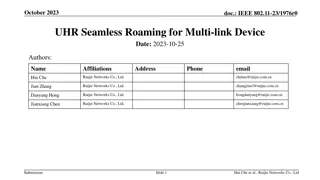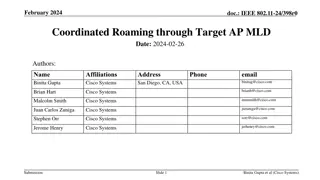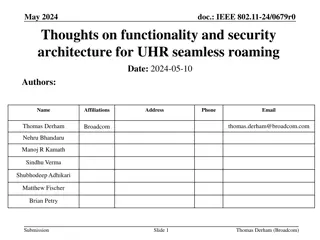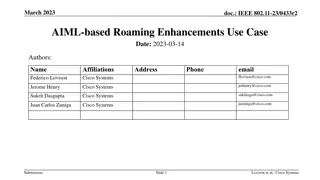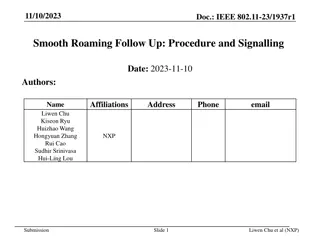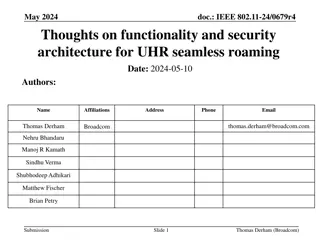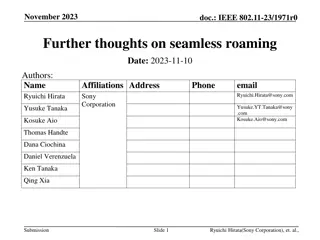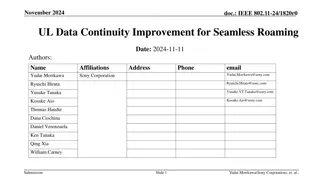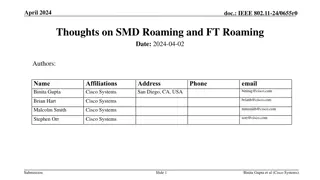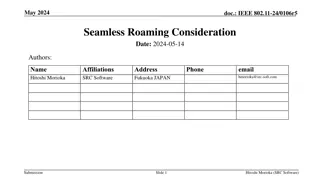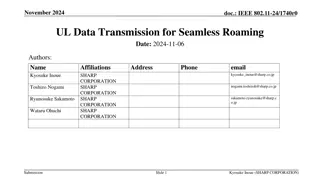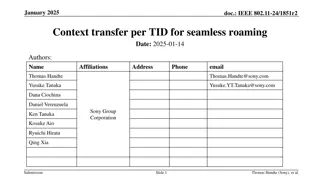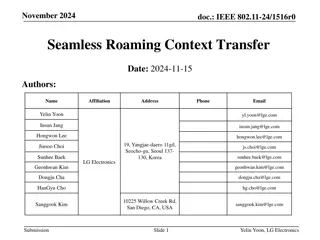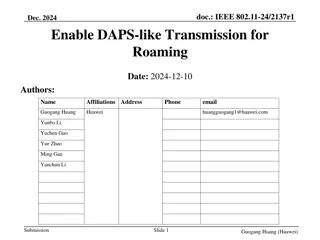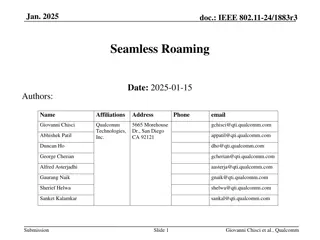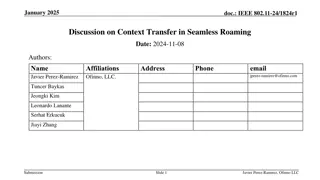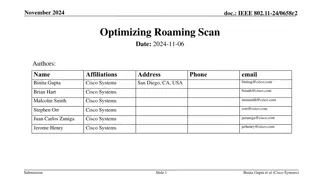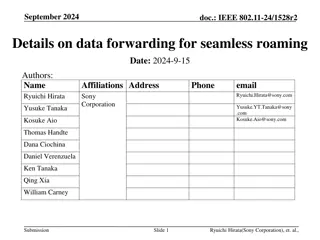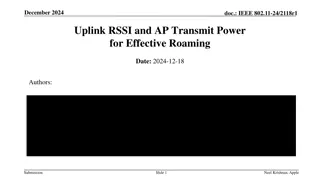
Seamless Roaming Framework for Ultra High Reliability
Introducing a seamless roaming framework to address the challenges in providing reliable connectivity and quality of experience for mobile users. The framework aims to achieve Ultra High Reliability (UHR) by enabling non-AP STAs to roam without re-association, re-authentication, and data discontinuity. Key features include data continuity, efficient frame exchanges, context agreement maintenance, and legacy support.
Download Presentation

Please find below an Image/Link to download the presentation.
The content on the website is provided AS IS for your information and personal use only. It may not be sold, licensed, or shared on other websites without obtaining consent from the author. If you encounter any issues during the download, it is possible that the publisher has removed the file from their server.
You are allowed to download the files provided on this website for personal or commercial use, subject to the condition that they are used lawfully. All files are the property of their respective owners.
The content on the website is provided AS IS for your information and personal use only. It may not be sold, licensed, or shared on other websites without obtaining consent from the author.
E N D
Presentation Transcript
January 2024 doc.: IEEE 802.11-23/1907r1 Seamless Roaming in 11bn Date: 2024-01-17 Authors: Name Affiliation Address Phone Email Yelin Yoon yl.yoon@lge.com Insun Jang insun.jang@lge.com Jinsoo Choi js.choi@lge.com Sunhee Baek Geonhwan Kim Dongju Cha sunhee.baek@lge.com geonhwan.kim@lge.com 19, Yangjae-daero 11gil, Seocho-gu, Seoul 137- 130, Korea dongju.cha@lge.com Eunsung Park esung.park@lge.com LG Electronics Dongguk Lim dongguk.lim@lge.com Jinyoung Chun jiny.chun@lge.com Insik Jung insik0618.jung@lge.com HanGyu Cho hg.cho@lge.com 10225 Willow Creek Rd, San Diego, CA, USA Sanggook Kim sanggook.kim@lge.com Submission Slide 1 Yelin Yoon, LG Electronics
January 2024 doc.: IEEE 802.11-23/1907r1 Abstract Seamless mobility, a feature outlined in UHR PAR, requires a mechanism that ensures reliable connectivity and quality of experience for mobile users [1] In this presentation, we introduce a seamless roaming framework to address these requirements Submission Slide 2 Yelin Yoon et. al, LG Electronics
January 2024 doc.: IEEE 802.11-23/1907r1 Motivation (1/2) Current roaming mechanisms, including Fast BSS Transition, fall short in providing seamless roaming Despite its attempts to expedite the process, re-authentication and re- association process lead to significant time delays. Additionally, the data discontinuity experienced during disassociation and re-association with the target AP further aggravates these delays. Submission Slide 3 Yelin Yoon et. al, LG Electronics
January 2024 doc.: IEEE 802.11-23/1907r1 Motivation (2/2) We need a new framework to achieve Ultra High Reliability (UHR) which allows the non-AP STAs to roam without re-association, re- authentication, and data discontinuity. This framework should address the challenges posed by current methods by implementing key features: Data Continuity: Ensuring Seamless data transfer and facilitating the exchange of data between the serving AP MLD and the target AP MLD Efficient Frame Exchanges: Minimizing the delays caused by frame exchanges during re-authentication and re-association processes Preserving the Multi-Link Setup Context Agreement Maintenance: Sharing necessary information, such as contexts and agreements, between the AP MLDs Legacy support: Ensuring compatibility with legacy systems and devices Submission Slide 4 Yelin Yoon et. al, LG Electronics
January 2024 doc.: IEEE 802.11-23/1907r1 Roaming Architecture We want to use the MLD based architecture to enable roaming The APs that support seamless roaming are affiliated with the Ultra Fast BSS Transition (UFT) AP MLD The UFT AP MLD has its own MAC SAP The UFT AP MLD has its unique MLD MAC address and it shall be announced in management frames ( e.g. beacon as in 11be) The UMAC of the UFT AP MLD manages the UMAC functions of the AP MLDs, including: multi-link setup, authentication, reconfiguration, Block Ack agreement, Security Key, SN, PN, etc. There are no architectural changes in the AP MLDs for a legacy support An UHR non-AP MLD, designed to enable seamless roaming, can identify the UFT AP MLD Submission Slide 5 Yelin Yoon et. al, LG Electronics
January 2024 doc.: IEEE 802.11-23/1907r1 Identification When a non-AP STA is roaming to other APs, we need a method to identify the APs IDs will be used to identify the APs and will be announced before roaming Through IDs, a non-AP STA can check whether a specific AP is affiliated with the same UFT AP MLD with which the current AP is affiliated. We can assign an UFT AP MLD ID to the UFT AP MLD. The UFT AP MLD ID needs to be announced by affiliated APs (e.g. Through RNR) Instead of assigning the UFT AP MLD ID, we may just indicate whether the announced APs are affiliated with the same UFT AP MLD Within the same UFT AP MLD, the non-AP STA should be able to identify the AP MLD as well. However, the current AP MLD ID cannot be used in the roaming due to the following reasons Assigning an AP MLD ID to another AP MLD necessitates co-location. It cannot assign the AP MLD ID to the non-collocated AP MLD. The AP MLD ID of the current AP is always set to 0. This might lead to confusion, especially when a non-AP MLD is connected to multiple APs affiliated with different AP MLDs Submission Slide 6 Yelin Yoon et. al, LG Electronics
January 2024 doc.: IEEE 802.11-23/1907r1 Identification - Collocated AP MLD Set Our goal is to guarantee seamless roaming while moving from one AP to another AP that is physically far apart We group the AP MLDs that are co-located into a Collocation AP MLD set, and the UFT AP MLD assigns an ID to each set. The Collocation AP MLD set contains one ore more AP MLDs The non-AP STA only roams to the AP that is affiliated with the AP MLD that is in the different Collocation AP MLD Set. The Collocation AP MLD set ID and the link ID are used to identify the AP for roaming Submission Slide 7 Yelin Yoon et. al, LG Electronics
January 2024 doc.: IEEE 802.11-23/1907r1 Roaming Procedure Overview An MLD based architecture allows the non-AP STA to roam between the APs using reconfiguration frames It streamlines the roaming steps It reduces the roaming time It ensures the data continuity Before a non-AP MLD roams to another AP MLD, the UFT AP MLD can provide some information. The UFT AP MLD announces the information of the affiliated APs to the non-AP STA (e.g. via Beacon or Probe Request/Response frames) Whether the AP supports Seamless Roaming Whether the AP is in a different Collocation AP MLD Set The UFT AP MLD may provide a list of recommended APs The non-AP STA can request for the recommendation (e.g. Reconfiguration Notify frame, BTM) based on the information of APs obtained during announcement The UFT AP MLD may send without any request from the non-AP STA (e.g. Reconfiguration frame, BTM) How these information will be signaled is TBD Submission Slide 8 Yelin Yoon et. al, LG Electronics
January 2024 doc.: IEEE 802.11-23/1907r1 Roaming Procedure During Roaming (1/2) During roaming, both AP MLD and non-AP MLD maintain the Multi- Link Setup using a Reconfiguration process The roaming triggering procedure involves: The non-AP MLD or UFT AP MLD selects the target AP MLD for roaming and sends a Reconfiguration Request frame Upon accepting the roaming request, the UFT AP MLD or the non-AP MLD responds with a Reconfiguration Response frame Submission Slide 9 Yelin Yoon et. al, LG Electronics
January 2024 doc.: IEEE 802.11-23/1907r1 *New link: the link between the target AP MLD and the non-AP MLD *Old link: The link between the serving AP MLD and the non-AP MLD Roaming Procedure During Roaming (2/2) The Reconfiguration frame includes two methods of link transition[4]: Link add then delete (preferred) - A *new link is added, and subsequently, the *old link is deleted The non-AP MLD establishes a new link with the target AP MLD first Once the new data path is operational, data from the DS is transferred to the target AP MLD The link connected to the serving AP MLD is then deleted During roaming, at least one link must be maintained between the UFT AP MLD and non- AP MLD Requirement: This method requires non-AP MLD support for dual connectivity. Link switch - Delete then add at once: The old link and the new link are deleted and added simultaneously The UFT AP MLD/non-AP MLD announces the link it intends to delete and add in a single frame A timer is set for link deletion while data is shared via the newly added link Upon the timer expiration, roaming concludes Requirement: If the new link operates on a different channel, the AP MLD may need to notify the remaining time for the channel switch. NOTE - Data continuity cannot be guaranteed in single STA operation. Submission Slide 10 Yelin Yoon et. al, LG Electronics
January 2024 doc.: IEEE 802.11-23/1907r1 Ultra Fast BSS Transition (UFT) AP MLD An AP MLD that meets the following requirements: AP MLDs that are in the same ESS are affiliated with the UFT AP MLD Both AP MLDs that are part of the same collocated AP MLD set, as well as those in different collocated AP MLD sets, are affiliated with the UFT AP MLD The UFT AP MLD supports a seamless transition between AP MLDs that are not in the same collocated AP MLD set Submission Slide 11 Yelin Yoon et. al, LG Electronics
January 2024 doc.: IEEE 802.11-23/1907r1 Conclusion In this contribution, we introduce the UFT AP MLD, a novel solution enabling seamless roaming among its affiliated APs. Our proposal includes an analysis of the UFT AP MLD s architecture and the configuration of AP MLD IDs We have also introduced terminology associated with the UFT AP MLD Additionally, we have outlined a roaming process utilizing the Reconfiguration. This process includes the establishment of a recommended AP list and two methods of link transition, ensuring efficient and seamless connectivity during roaming Submission Slide 12 Yelin Yoon et. al, LG Electronics
January 2024 doc.: IEEE 802.11-23/1907r1 Straw Poll #1 Do you agree with the definition of the collocated AP MLD set: The set containing one or more AP MLDs that are co-located NOTE - The collocated set is in the same ESS NOTE - The method to identify the set is TBD Submission Slide 13 Yelin Yoon et. al, LG Electronics
January 2024 doc.: IEEE 802.11-23/1907r1 Straw Poll #2 Do you agree with the definition of an Ultra Fast BSS Transition (UFT) AP MLD: An AP MLD with which APs that are co-located or not are affiliated APs that are not collocated are affiliated with EHT AP MLDs included in different collocated AP MLD sets NOTE The exact name can be changed Submission Slide 14 Yelin Yoon et. al, LG Electronics
January 2024 doc.: IEEE 802.11-23/1907r1 Straw Poll #3 Do you support the following: An UFT AP MLD has its own singly identifying MLD MAC Address Submission Slide 15 Yelin Yoon et. al, LG Electronics
January 2024 doc.: IEEE 802.11-23/1907r1 Straw Poll #4 Do you support the following: AP affiliated with the UFT AP MLD shall announce the UFT AP MLD s MLD MAC Address via Beacon and Probe Response frames Signaling is TBD Submission Slide 16 Yelin Yoon et. al, LG Electronics
January 2024 doc.: IEEE 802.11-23/1907r1 Straw Poll #5 Do you support to define a method for identifying an UFT AP MLD NOTE Using the method, a non-AP STA affiliated with a non- AP MLD can be aware that the associated AP and a reported AP are affiliated with the same UFT AP MLD Submission Slide 17 Yelin Yoon et. al, LG Electronics
January 2024 doc.: IEEE 802.11-23/1907r1 Straw Poll #6 Do you support the following: The UFT AP MLD assigns an unique ID to each collocated AP MLD set Submission Slide 18 Yelin Yoon et. al, LG Electronics
January 2024 doc.: IEEE 802.11-23/1907r1 Straw Poll #7 Do you support that: A non-AP MLD which can identify an UFT AP MLD may initiate a multi-link setup with the UFT AP MLD Submission Slide 19 Yelin Yoon et. al, LG Electronics
January 2024 doc.: IEEE 802.11-23/1907r1 Straw Poll #8 Do you support the following: Seamless Roaming Multi-Link reconfiguration refers to a set of procedures through which a non-AP STA can add and delete one or more links connected with AP MLDs Submission Slide 20 Yelin Yoon et. al, LG Electronics
January 2024 doc.: IEEE 802.11-23/1907r1 References [1] 11-23/480r3 UHR draft proposed PAR [2] 11-23/279r0 Considerations on Seamless Roaming [3] 11-23/1090r0 Seamless Roaming Follow-up [4] 11-23/1908r0 Seamless Roaming Procedure Submission Slide 21 Yelin Yoon et. al, LG Electronics
January 2024 doc.: IEEE 802.11-23/1907r1 Appendix Link Add then Delete Link Switch Submission Slide 22 Yelin Yoon et. al, LG Electronics
January 2024 doc.: IEEE 802.11-23/1907r1 Appendix Link Delete then Add Submission Slide 23 Yelin Yoon et. al, LG Electronics

